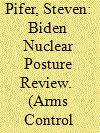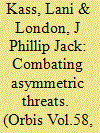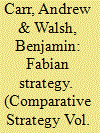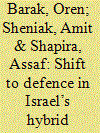|
|
|
Sort Order |
|
|
|
Items / Page
|
|
|
|
|
|
|
| Srl | Item |
| 1 |
ID:
183356


|
|
|
|
|
| Summary/Abstract |
President Joe Biden’s administration is conducting a missile defense review in parallel with its Nuclear Posture Review (NPR). Those reviews will determine whether to adjust the nuclear and missile defense programs that the administration inherited from its predecessor. They will also shape decisions on the contribution that negotiated arms control could make to meet the increasingly complex challenges of maintaining strategic stability and enhancing U.S. and allied security.
|
|
|
|
|
|
|
|
|
|
|
|
|
|
|
|
| 2 |
ID:
129909


|
|
|
|
|
| Publication |
2014.
|
| Summary/Abstract |
The overarching objective of this analysis is to examine the ways and means by which the United States could take the asymmetric battle-space and win against the ever-changing array of threats posed by nation-states and non-state actors. Today's security challenges are predominantly hybrids: offense and defense; symmetric and asymmetric; synchronous and asynchronous; regular and irregular; geographically-focused and globally-ubiquitous. This reality requires multi-dimensional thinking, nuanced approaches, and nimble, decisive execution guided by a new strategic paradigm. Fighting on the enemy's terms, scoring short-term wins at unjustifiably high costs in lives, treasure and lost opportunities is simply unacceptable.
|
|
|
|
|
|
|
|
|
|
|
|
|
|
|
|
| 3 |
ID:
188346


|
|
|
|
|
| Summary/Abstract |
The Fabian strategy is one of the most famous military strategies. Yet beyond notions of withdrawal and trading “space for time”, there is little clarity in the literature about how it operates. In this article, we develop a framework to explain the strategy based wearing down an adversary over time and then seeking a battlefield decision. We also examine contingent factors in shaping success or failure. In the final section, we explore what the Fabian strategy, famous for its use of time, tells us about acting strategically in the temporal domain.
|
|
|
|
|
|
|
|
|
|
|
|
|
|
|
|
| 4 |
ID:
193163


|
|
|
|
|
| Summary/Abstract |
This paper traces the significant change that has occurred in the balance between offense and defence in Israel’s ‘hybrid’ military strategy in recent decades. Relying on fresh materials concerning the organizational, doctrinal, and procurement processes of Israel’s military, we identify a shift from offense towards defence as the preferred way to protect Israel in the face of new security threats. We also show that due to rapidly changing security challenges, limited resources, and the military’s organizational culture, this change has been gradual, incremental, improvised, and largely informal. We propose that similar changes may characterize other states facing new security challenges.
|
|
|
|
|
|
|
|
|
|
|
|
|
|
|
|
| 5 |
ID:
140403


|
|
|
|
|
| Summary/Abstract |
It is widely believed that cyberspace is offense dominant because of technical characteristics that undermine deterrence and defense. This argument mistakes the ease of deception on the Internet for a categorical ease of attack. As intelligence agencies have long known, deception is a double-edged sword. Covert attackers must exercise restraint against complex targets in order to avoid compromises resulting in mission failure or retaliation. More importantly, defenders can also employ deceptive concealment and ruses to confuse or ensnare aggressors. Indeed, deception can reinvigorate traditional strategies of deterrence and defense against cyber threats, as computer security practitioners have already discovered. The strategy of deception has other important implications: as deterrence became foundational in the nuclear era, deception should rise in prominence in a world that increasingly depends on technology to mediate interaction.
|
|
|
|
|
|
|
|
|
|
|
|
|
|
|
|
|
|
|
|
|